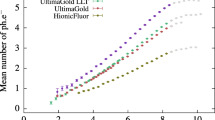Abstract
The quench level of different liquid scintillation counting samples is measured by comparison of the responses (pulse heights) produced by the same energy electrons in each sample. The electrons utilized in the measurements are those of the maximum energy (Emax) which are produced by the single Compton scattering process for the same energy gamma-rays in each sample. The relation of the Emax response produced in any sample is related to the Emax response produced in an unquenched, sealed standard. The relation, difference in response on a logarithm response scale, is defined as the “H Number,” H#. The H# is related to the counting efficiency of the desired radionuclide by measurement of a set of standards of known amounts of the radionuclide and different amounts of quench (standard quench curve). This report presents the theory of the H# concept. Several of the unique features of the H# method are discussed. Quench curves based upon the H# are compared to other previously used methods of quench monitoring.
Similar content being viewed by others
References
D. L. HORROCKS, Nucl. Instr. Meth., 30 (1964) 157.
D. L. HORROCKS, Nucl. Instr. Meth., 117 (1974) 589.
Author information
Authors and Affiliations
Additional information
D. L. Horrocks, US Patent No. 4,075,480.
Rights and permissions
About this article
Cite this article
Horrocks, D.L. A new method of quench monitoring in liquid scintillation counting: The H number concept. J. Radioanal. Chem. 43, 489–521 (1978). https://doi.org/10.1007/BF02519509
Received:
Issue Date:
DOI: https://doi.org/10.1007/BF02519509




